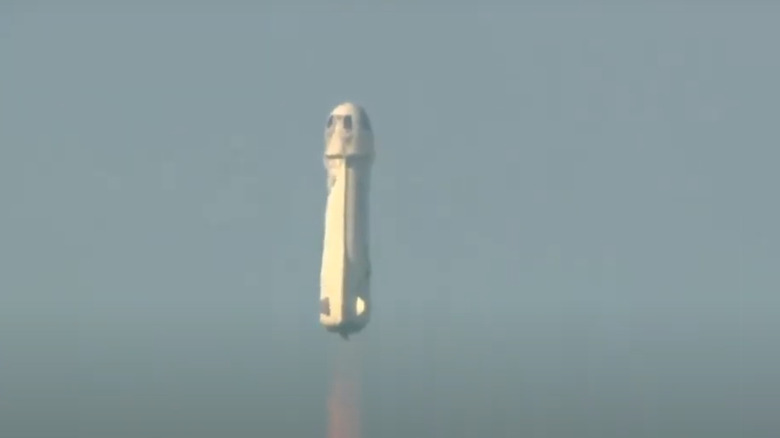What We Know About Jeff Bezos' Explosive Rocket Failure
The early days of September 2022 have not been good for space exploration. As The New York Times reports, twice in a matter of days, NASA was forced to scrub the launch of Artemis I, which was intended to pave the way for an eventual return to manned moon missions. Unfortunately, the launch has been moved back to October at the earliest. "This is part of our space program. Be ready for our scrubs," quipped NASA administrator Bill Nelson, without a hint of irony.
Over on the private space exploration side of things, the bad month continues. On September 12, Amazon founder Jeff Bezos' Blue Origin space program was scheduled to launch the New Shepard Capsule into orbit (via The Independent). However, the launch was bedeviled by a technical issue that caused one of its booster rockets to explode, causing the mission to be aborted. Fortunately, there were no human passengers on board the craft. Further still, the jettison process allowed the capsule and its contents to return safely to Earth.
'We're Responding To An Issue This Morning'
Blue Origin's mission NS-23 (which is to say, the 23rd mission of the New Shepard spacecraft) was simultaneously a success and a failure, according to The Independent. It was a failure in that a rocket appears to have failed, but a success in that the redundant systems in place in case of such a failure all seem to have worked perfectly.
As IFLScience reports, the craft launched from a Texas launch pad as scheduled, and the first few minutes of the mission went swimmingly. That is, until it didn't. As the craft was approaching 8.5 kilometers (5.28 miles) above the ground, at the point where maximum pressures would be applied to it, something happened, although exactly what remains to be seen. In an instant, the payload — the New Shepard craft containing supplies, which would have contained astronauts had this been a manned mission — separated from its rocket. Its parachutes deployed, and the spacecraft returned to Earth, landing gently on the ground.
"We're responding to an issue this morning at our Launch Site One location in West Texas," tweeted Blue Origin, adding that more information will be provided as it becomes available.
So What Happened?
As of this writing, it's not clear what happened that set into motion the sequence of events that ended with New Shepard on the ground instead of in space. "It appears we have experienced an anomaly with today's flight. This was unplanned and we don't have any details yet, but our crew capsule was able to escape successfully," said spokesperson Erica Wagner (via IFLScience). There was, of course, no crew, but the New Shepard capsule is capable of taking crews to space, and had this mission been manned, they'd have been there (and they'd have survived, since the craft landed safely).
On his YouTube channel, Scott Manley posits that it was an engine failure, a claim seemingly backed up with video evidence. It's difficult to see since the craft was miles above the ground when it happened, plus the vehicle is only in the frame for a fraction of a second, but at 1:11 in the video, it appears as if a rocket launching the vessel bursts into flames. The camera then focuses solely on the New Shepard craft, being propelled by its own rockets as opposed to the boosters that launched it.
The Independent also claims that a booster rocket exploded. However, Blue Origin has not yet indicated what caused this explosion.


